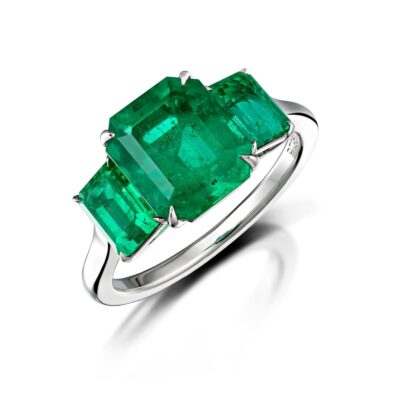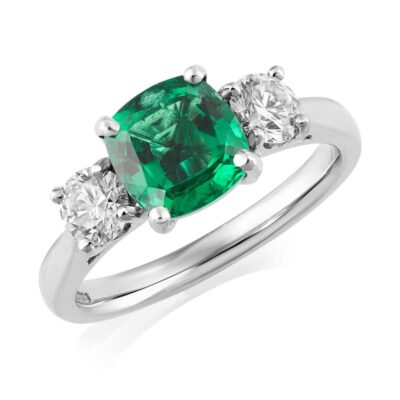Emerald Engagement Rings
Prized for their beauty and scarcity, records show that emeralds were sold in markets in Babylon as early as 4000 BC, and that the gemstone was mined by the ancient Egyptians. Nowadays major deposits are mined in Colombia and Zambia, but emeralds are also found in a wide range of other countries from Australia and India to Italy and Spain.

Emerald is a captivating gemstone, and makes a striking and elegant choice for an engagement ring. However, emerald has some unique properties that make it different to the rest of the ‘big four’ (the others being diamond, sapphire and ruby). Before making a decision it is well worth taking a bit of time to understand them.
The Finest Emeralds Are Pure Green Or Green With A Hint Of Blue
A member of the beryl family of gemstones, the colour of an emerald is determined by trace elements of vanadium, chromium and iron within the crystal, and defined in terms of its hue, saturation and tone. Hue refers to the shade of green, for example it might contain a faint hint of yellow or blue. Generally pure green or a faint hint of blue are considered the most desirable hues. Saturation refers to how intense the colour is; generally the more intense the better. Tone refers to how light or dark the stone is, with a medium tone (not too dark) generally considered the best.
Flawless Emeralds Are Extremely Rare

Nearly every emerald will have some visible blemishes or ‘inclusions’, which can include mineral impurities, tiny fractures, or growth lines in the crystal, varying from the barely perceptible to the very pronounced. Emeralds that are completely free of inclusions are extremely rare and exceptionally valuable. Carat for carat, the very best emeralds can be two to three times as valuable as a diamond. So, depending on your budget, if the idea of a gemstone not looking completely flawless bothers you, an emerald may not be your best option!
Emeralds Are Relatively Soft
Any piece of jewellery can be damaged through wear and tear, but if you’ve got your heart set on an emerald engagement ring, please be aware that you’ll need to be extra careful with it. Emerald is not a very hard gemstone, scoring 7.5-8.0 on the Mohs hardness scale, compared with 9 for sapphire and ruby and 10 for diamond (ten times harder still).
An emerald’s inclusions are its natural weak spots, so if you bump your ring against something hard, you can cause inclusions to become more visible, not to mention the potential for causing more serious damage. Its comparative softness also needs to be taken into consideration when setting an emerald. Platinum is less malleable than gold, and so needs more force applied to it when setting a stone – a setter will need to take extra care when setting an emerald in platinum.
Many Emeralds Are Oiled To Improve Their Appearance
Finally, as with any gemstone, before you buy an emerald you should check whether it has been subjected to any form of treatment. Treatments are often used to enhance an emerald’s appearance, and are not necessarily a problem, so long as they have been disclosed, and you understand their implications. Many emeralds are oiled to improve their colour and clarity, and even an emerald that has not been actively oiled is likely to have been exposed to minor traces of oil from the cutting wheel on which it was faceted. Over time the oil may dry out, making any inclusions more visible and the colour of the stone less vibrant. If that happens, the emerald’s former appearance can be restored by re-oiling it an simple and inexpensive process. Sometimes coloured oils and dyes are used, but these can fade if the stone is exposed to strong light. Alternatively, some emeralds have their surface-reaching inclusions filled with glass or resin to superficially improve their appearance, but this can leave these stones in an unstable condition, vulnerable to changes in air pressure, heat, and various chemicals. We would recommend steering clear of dyed stones or ones that have been treated with glass or resin. If you have any concerns about whether an emerald has been treated, you should consider having it examined by an independent gemologist.
Ethical Emeralds
At A Star Diamonds we source only emeralds that have been produced in a socially and environmentally responsible way, and which we can trace back to mine of origin. The only treatment we accept is oiling with colourless oil, and we also offer un-oiled emeralds.
Please feel free to get in touch if you have any questions, or to discuss commissioning your own bespoke design.
